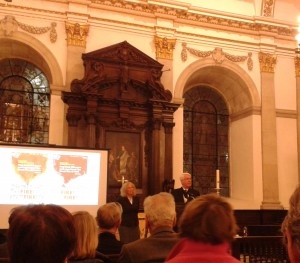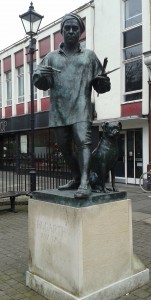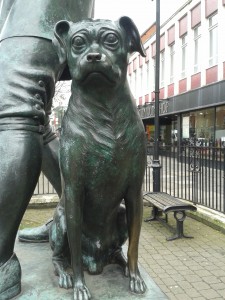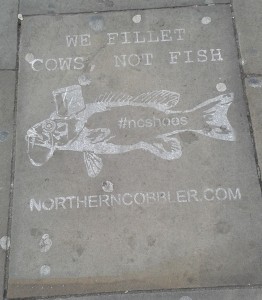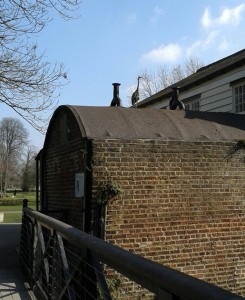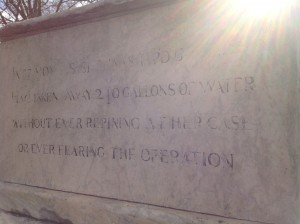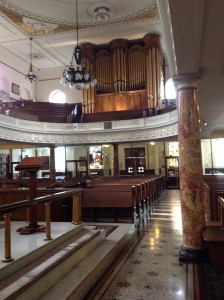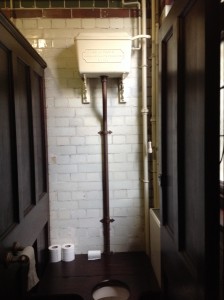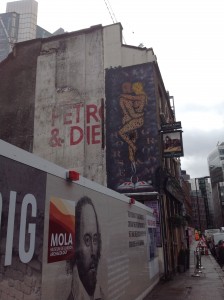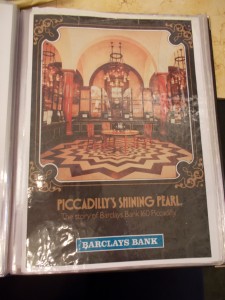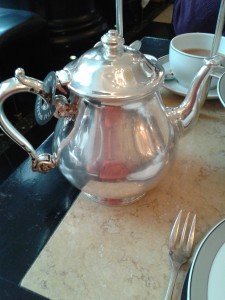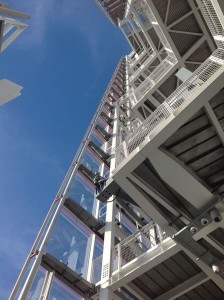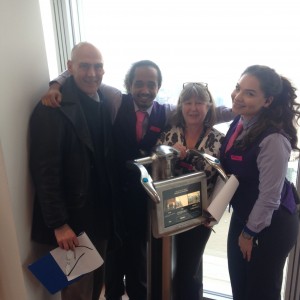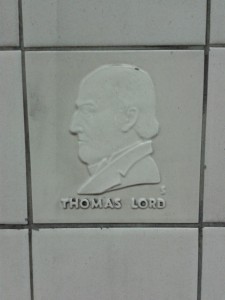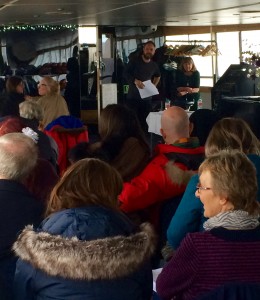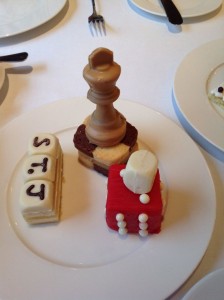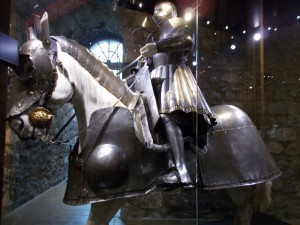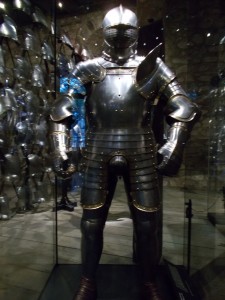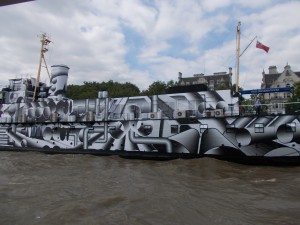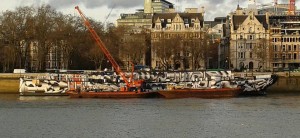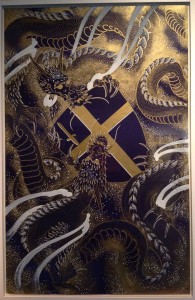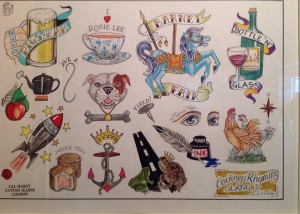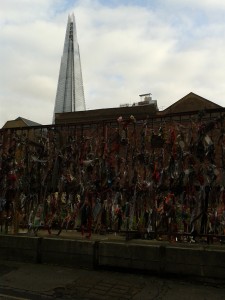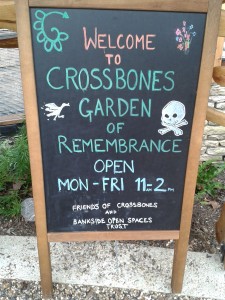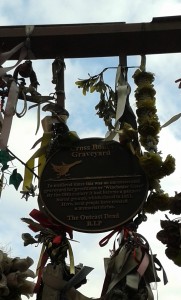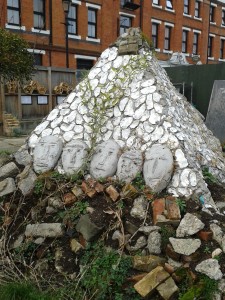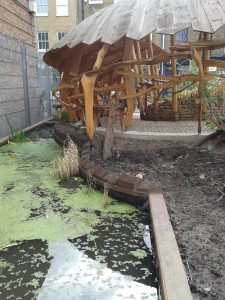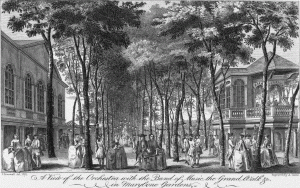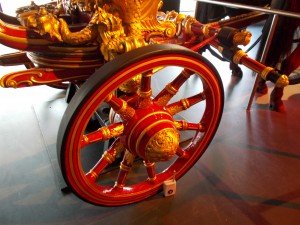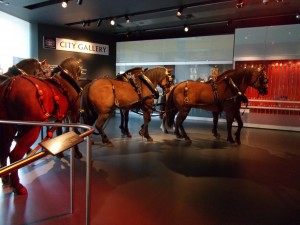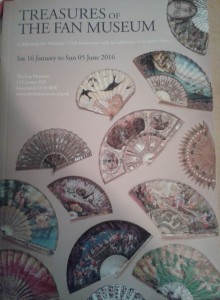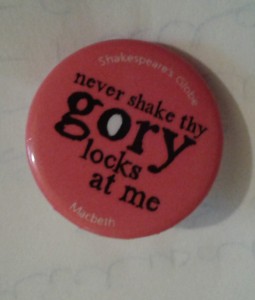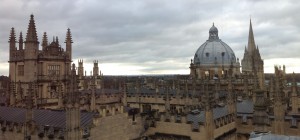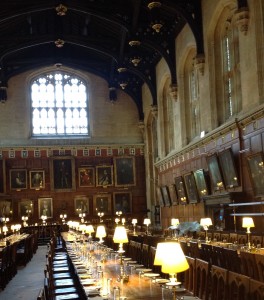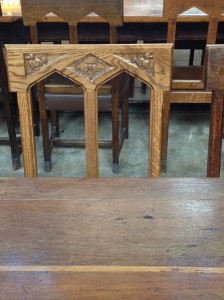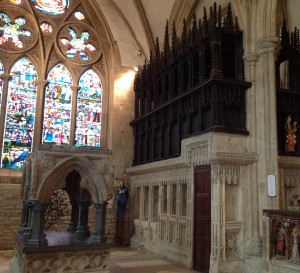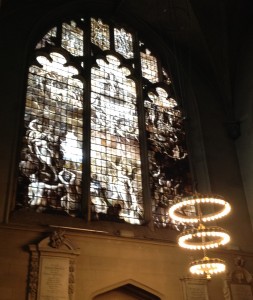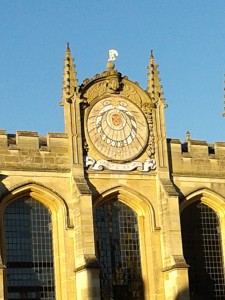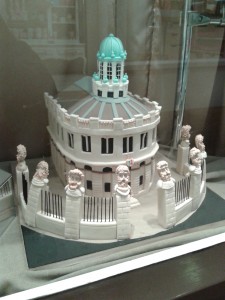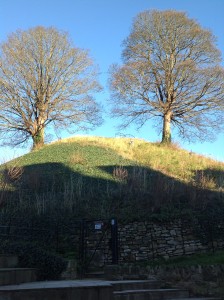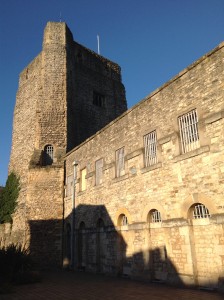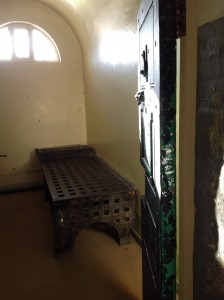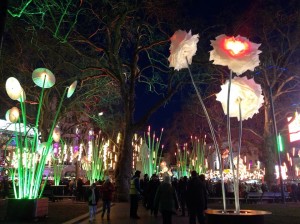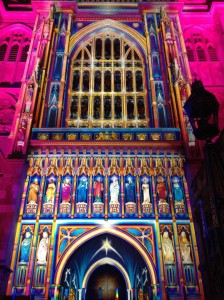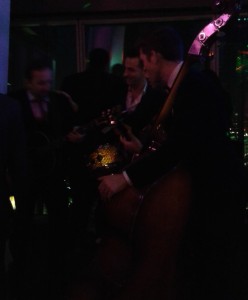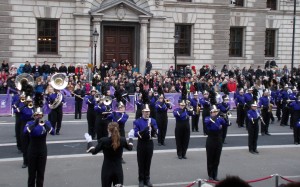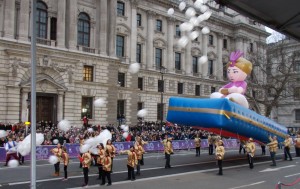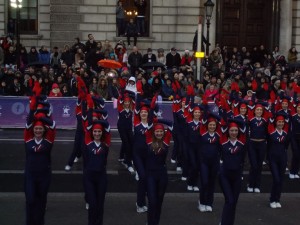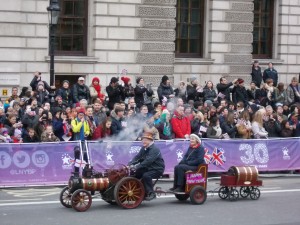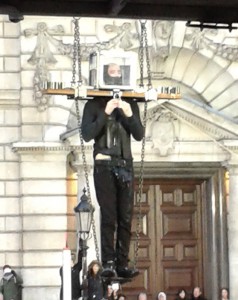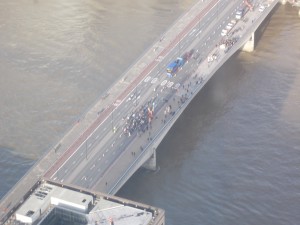Julie
Diary of a Guide…Fish, Herons and a pug named Trump
A mixed week of lectures, meetings, scouting walks (again) and hidden gems.
Monday
Worked at home today catching up on paperwork and then went off this evening to the City for the City of London Guide Lecturers Association’s annual Melluish lecture, which this year was given by Museum of London Director, Sharon Ament and, this being an anniversary year, was on the Great Fire of London.
The lecture was held in the beautiful church of St Lawrence Jewry, the official church of the Lord Mayor of London and the City of London Corporation, and we were warmly welcomed by the vicar, Canon David Parrott. Appropriately, St Lawrence Jewry was rebuilt by Sir Christopher Wren following the 1666 Fire. There has been a church on the site since the 12th century, and Wren’s church was restored in the 1950s, having been badly damaged in the Blitz of 1940.
Sharon presented an interesting lecture that, not only told the basic story of the Great Fire, but also looked at it from the perspective of modern day crisis management. It was a different angle to take, but one that got a room full of City guides, who all know about the Great Fire, thinking about what in Sharon’s words would be called ‘a major incident’ today.
The Lord Mayor of the time, Sir Thomas Bludworth, came in for a bit of criticism regarding his lack of action but, in fairness to him, if he had started pulling down houses to create fire breaks without agreement from a higher authority, i.e. the King, then he could have been sued – see, and we thought litigation was a modern disease! You do have to feel a little sorry for the man as his year in office saw both the Great Plague and the Great Fire devastate London and, in his own words, he had “the severest year any man had”.
Sharon summed up why the Great Fire was so disastrous in three key points, aside from the baker not putting his ovens out properly. Firstly, complacency – fires were a regular occurrence back then and there was no reason at the start to think this fire was any different. Second, poor leadership – no one took control initially and it took time to mobilise troops and co-ordinate the fire-fighting efforts. And lastly, a lack of equipment – fire hooks, leather buckets and squirts were supposed to be kept in every parish church for use against fire, but this was not always the case.
The Museum of London has a new exhibition due to open in July for the 350th anniversary of the Great Fire, and ‘Fire! Fire!’ is sure to be this year’s hot ticket!
Thursday
Travelled over to Chiswick today for a meeting with a tour operator about some coach tours later in the summer. It took me back a good few years, as I used to work at Barclays Bank in Chiswick High Road in the late 1980s. The branch itself was completely unrecognisable, all shiny glass and automated tills, but the pub next door, aside from a refurbishment, hadn’t really changed at all. The Packhorse and Talbot was always a favourite haunt after work on a Friday evening when we’d all troop straight next door for a drink.
However, outside the Barclays I found a gem that certainly wasn’t there back in my day – a statue of Trump! No, not the US politician and billionaire Donald, but a pug called Trump, along with his more famous master William Hogarth. The 18th century artist, and his pet dog, lived locally and you can visit Hogarth’s country retreat, but sadly I didn’t have time today so it’s one to stick on my list for another time.
Saturday
Spent the morning doing a final recce of my Shoreditch walk that I’m leading on Monday evening. It takes a long time to get a walk right – contrary to popular belief guides don’t just turn up and talk about anything (not professionals anyway), and I have my own method for creating a walk.
First I come up with an area or theme (this might be dictated by the client), then I research the area and potential topics and work out a rough route on a map before going out to walk the potential route. Then more research, finalise the stops, walk the route again, and again, and then walk it forwards and backwards making any final changes. The backwards bit I find is very important, as you will often spot something that you just don’t see while walking in one direction only.
Looking up at the tops of buildings and down at the ground also occasionally reveals an overlooked gem, which is how I found the advert about cows and fish on a paving stone in Shoreditch High Street. They sell hand-crafted shoes in a shop in Leicester (I googled them), but I have absolutely no idea what their connection with Shoreditch, or fish, is!
Another gem, although thankfully easier to spot, was St Leonard’s Parish Church. The burial place of Richard Burbage, Shakespearian actor and the star of many of his plays, he was the first actor to play Hamlet, Romeo and dastardly Richard III. The church also has a lovely cottage garden complete with a wishing well and Shakespearian quotes. Not really what you expect to find at the top of Shoreditch High Street in amongst all the trendy bars and shops, but a pleasant oasis away from the noise of the traffic.
Sunday
Today was my first tour of the year at the National Trust’s Morden Hall Park – another oasis in London. I’ve been volunteering as a tour guide at what is effectively my local park for the past 5 years, and the history tours run every Sunday between March and October.
Morden Hall Park was a family estate that was left to the National Trust in 1941 when the last private owner, Gilliat Edward Hatfeild died – and no I haven’t spelt Hatfeild wrong, and no the family are not connected to Hatfield House (note the different spelling). Unlike most National Trust properties the park is free to enter as Hatfeild’s bequest stated the park should be run by the National Trust for the local people ‘provide a fee not be charged nor the gates locked’.
The park has a long history. First mentioned in the Domesday Book, the land was originally owned by Westminster Abbey before reverting to the Crown at the dissolution of the monasteries in the 1530s. Bought by two merchants in the mid 1500s, it was then sold to the Garth family who owned it for about 300 years before selling the estate to the Hatfeilds. The Hatfeilds were tobacco merchants and it was the snuff mills in the park, still there today but no longer operational, that brought them to the area.
The hall itself has never been open to the public (no original furniture and no money to bring it back to life as a stately home) and, like many of the cottages on the estate, it is rented out to bring in much needed income to support the park and its activities. However, there are many interesting features that make for a great walk round the park; the aforementioned snuff mills, Mr Hatfeild’s rose garden, and the Victorian stableyard to name a few. Plus the River Wandle runs through the park and the wetlands area attracts lots of birds and wildlife.
Today I was particularly fortunate to catch one of the herons posing in the sunshine on top of the eastern snuff mill – looks like he’s waiting to catch a fish, or maybe he’s just hiding from Trump?!
Diary of a Guide…Murals, More Toilets and Tea
This week was full of murals, more toilets, and topped off with a splendid serving of afternoon tea.
Monday
Got a little side-tracked today while I was scouting a walk. Having mapped it out on paper and undertaken some initial research for the walk I’m leading in a few weeks’ time, my intention was to walk the route and finalise the stops I planned to make along the way. Just after setting off up City Road I took in Bunhill Fields, the non-conformist burial ground that houses the graves of John Bunyan (author of Pilgrim’s Progress), Daniel Defoe (famous for writing Robinson Crusoe), and poet and painter, William Blake.
But in amongst the famous are the not so famous; ordinary people who practised forms of religion that meant they could not be buried in consecrated ground, and some of the graves have interesting tales to tell. Especially, Dame Mary Page. The epitaph on her tomb dating from 1728 speaks volumes (or should that be gallons). Dame Mary, the wife of wealthy merchant, died aged 56 but was clearly a stoic woman who suffered greatly as ‘In 67 months she was tapped 66 times … 240 gallons of water drawn without ever repining at her case or ever fearing the operation.’
The now disused cemetery is frequented by many City workers as a place to sit and eat their lunch, and most respect the peace of the graveyard. Apart from a builder who, as I was photographing John Bunyan’s tomb, was relieving himself onto nearby graves! Incensed I ranted at him about the desecration of graves and how would he like it if someone wee’d on his relatives. Think the whole graveyard heard me – as a guide I can definitely project my voice and went into serious ‘outraged’ mode!
After that encounter, I popped into Wesley’s Chapel (www.wesleyschapel.org.uk) opposite for a little calm and, never having been there before, stumbled across an absolute gem.
Built in 1777-78 by John Wesley as the home of Methodism, and designed by the architect, George Dance the Younger, the chapel is full of light with a beautiful gallery running around the interior and just exudes calm. Free to enter, with an interesting museum in the basement, I also took a free guided tour of John Wesley’s house next door and learnt a lot about Wesley himself and the foundations of Methodism.
The man was amazing. He travelled the country on horseback covering somewhere in the region of 250,000 miles during his lifetime and preaching two to three times a day. When at home, he arose every morning at 4.00am to pray in the small prayer room off his bedroom – the rest of the household had a lie in and used to get up at 5.00am!
Now the house is lovely, the chapel beautiful, but best of all though are the toilets! The Gents to be exact (knock before you enter), which still have the original Victorian marble urinals, mahogany cubicles, and Thomas Crapper toilets. I love a good toilet, and Crapper’s are the best (never was a man more aptly named). Contrary to popular belief, he did not invent the flushing toilet. However, he did perfect it and became the leading toilet manufacturer of the day under the slogan ‘a certain flush with every pull!’
The Ladies loos are nowhere near as glamorous.
Wonderfully, Thomas Crapper’s are still around. Today, they have a great website where you can purchase all sorts of Crapper products online (www.thomas-crapper.com), so you can still buy Thomas Crapper toilets, washbasins and who doesn’t need their loo roll?!
Tuesday
This afternoon I took a train to the wilds of Dunstable to give a talk to their U3A History Group on the Great Fire of London. My ‘Follow the Fire’ talk and walk are proving very popular this year, as we commemorate 350 years of the Great Fire in September, and I already have a number of bookings with it hotting up in September – literally!
U3A groups are always a lovely audience, and this group was no exception as we took a virtual walk through the flames of 1666. From the baker’s house in Pudding Lane, we followed the fire as it devastated the City of London destroying everything in its wake – 13,000 houses, 51 livery company halls and 87 churches gone, including the great medieval cathedral of St Paul’s .
Just as I was dramatically talking about the lead roof of St Paul’s Cathedral melting, and flowing down the street like lava from a volcano, I heard…..a snore! As I carried on talking, studiously ignoring the snores coming from the front row, I could see someone out of the corner of my eye nudging the person next to them. Phew – it stopped. Only to start again, as I launched into the blame game that followed the fire (was it the Dutch, the French, the Catholics???). Now I like to think that my talks are quite interesting and entertaining and, in my defence, it was quite warm in the room, but occasionally people do nod off. The nudging started again as I raised my voice over the snores that were now reverberating around the room. People started to giggle, others were turning their heads to find the culprit and I was carrying on regardless with the execution of Robert Hubert, who had confessed to starting the fire (he hadn’t, but he was a convenient scapegoat).
The snores finally ceased, I finished my talk to questions and applause, and the person who had nodded off came up to me afterwards to say how much they’d enjoyed the talk!
Never really thought my voice was that soporific, but I am available for insomniacs and to get babies off to sleep!
Wednesday
Determined to complete my recce of the walk I’d started on Monday, I set off round Shoreditch in the icy drizzle and wind, and discovered more gems – murals to be exact. Shoreditch is very much an area for street art and you see it everywhere.
It’s hard to miss the colourful murals by David Shillinglaw on the walls of Zetland House, which was originally a print works for the Bank of England.
The Museum of London Archaeology (MOLA) hoardings on Curtain Road are easy to spot too. This is where Shakespeare performed in the 1577 Curtain Theatre, and where Romeo and Juliet was first performed. The remains of the theatre have been excavated by MOLA, before a new build goes up, and the website of the Horse and Groom pub next door reveals that the theatre was discovered under their Female toilets. They even have their own Romeo and Juliet mural on their pub wall!
Then on the side of a car park, just as I was seriously feeling the chill and planning to head home to warm up, I found Luke Skywalker and Darth Vader. Love Star Wars, so the sight of the Force battling the Dark Side in tiles for all eternity cheered me up, but the rain was getting worse so I took a quick phot and headed to the tube – hope Luke won!
Thursday
Today I finally managed to use the gift voucher I’d been given when I left the Museum of London (thank you to the host team) at the end of last year to become a fully self-employed guide, and headed to The Wolseley on Piccadilly for a spot of afternoon tea.
The old WolseIey car showroom from 1921 is now a luxurious restaurant, so afternoon tea was taken in the sumptuous surroundings of Eastern lacquerwork, marble flooring and impeccable service.
The Wolseley Car Company went bust in 1926 and the building then became an incredibly luxurious branch of Barclays Bank. Weirdly, I had spent time there in the 1990s when I worked for Barclays and had installed their new automated tills on the counter that was where the serving counters are today.
Tea was very genteel. Served in a beautiful silver teapot, with a silver tea strainer. The cake stand was filled with finger sandwiches (no crusts), warm fruit scones and dainty cakes and pastries. Absolutely delicious and it felt like I was back in the glamorous 1920s.
There’s something very decadent about taking afternoon tea, but John Wesley would probably not agree with me, as he hated tea and thought the drink ‘an abomination’!
Diary of a Guide…The Shard, Security and Stairs
This week I spent five days at The View From The Shard. Now, I haven’t worked five days on the trot since the end of the high tourist season in October – it felt like I had a proper job!
Monday
I started my week delivering landmark training for their new photographic team, Magic Memories, who are specialists in tourism photography.
Their strapline is ‘We Make People Smile’, and they certainly made me smile as the two managers, who were with the group of photographic hosts on their training, attempted to outdo each other in naming key landmarks. It was like having two naughty schoolboys on a school trip as first one then the other competed saying “I know that one” and “Ooh, let me try naming it”.
Like many visitor attractions, you have a photograph taken when you first enter The View From The Shard. However, the photographic hosts also roam the observation floors on Levels 69 and 72 taking in-situ photos with the view in the background. Many guests like to have a photo taken in front of a favourite landmark or iconic building, so as part of the training we not only discussed which landmark was which and which are the most popular (basically the big sexy ones like St Paul’s Cathedral and the Tower of London), but also how to frame a shot from 244 metres (800 feet) up in the sky.
Of course the ‘spire’ is a key feature of The Shard, rising from Level 72 (the highest floor the public can go on) to the very top of the building at Level 95 (309.6 metres or 1,016 feet above the ground). It’s quite spectacular having a photo with the spire as a backdrop, especially when it’s lit up at night. So we finished the training crouching down pretending to take photos of the spire, much to the amusement of other guests enjoying the view. Of course, you can get an even better shot if the photographic host lays on the floor of Level 72 and shoots up towards Level 95 right at the very top – weirdly, the team didn’t seem too keen on that idea!
Tuesday – Friday
Following the classroom-based training a few weeks ago, the rest of the week was spent with my colleague Bruce assessing the practical skills of the guest ambassadors in delivering their tours before they are let loose on the public. 18 trainees meant hearing 18 tours, all covering virtually the same view. Now you would think that over the course of the week I would get fed up hearing about the view, the various landmarks, the story of the Shard and the building itself. But not at all, because each trainee put their own personality into their tour and the view of London changed constantly. Well, not the actual buildings obviously, but how they look and which ones you can see depending on the weather.
As a professional guide I recognise all the landmarks, I generally know a fair bit about them and I also know quite a lot about The Shard, but I was pleasantly surprised by the trainees’ depth of knowledge and turn of phrase. Some approached the tour as a key highlights tour, others focused on London’s history, one gave us an architectural tour, and another took us on a tour of film locations that can be seen from the top. He even likened the view to Mary Poppins flying over the church steeples and the chimney pots!
Along the way, I discovered that the lift speed is the same as a male kangaroo at full hop, the window cleaners are the ‘daredevils’ of The Shard, and the Tower of London houses ‘the Queen’s bling’. My quote of the week though was being told that when Renzo Piano designed the building, he (apparently) wanted something ‘classy and glassy’.
It was fun listening to the different interpretations, but not so much fun going through the airport style security all those times. On the plus side, I’m now on first name terms with the security guys, know that the metal plates in my arm (broke it badly a few years ago) set off their scanners and can disrobe in under 5 seconds (that’s coat, bag, empty pockets etc., but you do get to keep your shoes on!). By the end of the week, I had it down to a fine art and could scoot through pretty quickly divesting myself of my bits and bobs.
But the worst part of the week had to be trekking up and down the stairs. You don’t have to walk up to the top on Level 72 as guests get whisked up via two speedy lifts. But I was based in the offices on Level 3 for the week and the easiest way to get to the attraction entrance is via the internal staircase. As I trudged up and down between tours, I noticed the signs telling me how many calories I burned by taking the stairs (3.99 per floor). So how many calories did I burn walking between Level 1 and Level 3 all week? A measly 287.28 calories! Which doesn’t sound a lot – until I worked out that the number of times I’d gone up and down was the equivalent to climbing all the way up to Level 72!
It was only on Friday that I discovered that out of the 40+ lifts within the building, there is only 1 that goes all the way from the bottom to the top. Some of the guest ambassadors refer to it as ‘the Queen’s lift’. Don’t know about the Queen, but might have been easier if I could have used it!
Diary of a Guide…Thames, Theft and Tiles?
This week saw me back in Bankside, on the Thames and discovering a surprising find in St John’s Wood.
Tuesday
All wrapped up and thermals donned for this evening’s ‘Bawdy Bankside’ walk for students at the new London campus of the University of West Scotland (www.uws.ac.uk/london). I was rather relieved when we met at their campus in Borough to find that everyone was sensibly dressed for the weather, especially as the students weren’t the hardy Scots I expected but overseas students from China.
The cold English weather had put some of the students off, but those who did brave the cold were enthusiastic about the walk and London, and bombarded me with questions throughout the tour.
Explaining the British way of life, our customs, and our language is one of the joys of being a tour guide. Cultural differences are always interesting, but have you ever tried to explain what a scone is to someone Chinese? It’s not easy. I mean who other than the British really understands why we smother a small fruit cake in jam and clotted cream? And I didn’t even bother to explain the jam then cream or cream then jam thing! I mean, who understands that anyway?
One of the students and I developed a rapport as it turned out we had both climbed Mount Tai, one of the holiest mountains in China (way back in 1996 for me), and we compared notes about the number of steps to the top (7,200), how long it took us (about 5 hours) and how cold it was on the top – much colder than Bankside in February!
This evening’s walk took us past St George the Martyr church with its chalk message board on the north side, which (surprisingly) had no rude messages – at least, I don’t think the Chinese writing is rude?!. Both there and at the site of the old Marshalsea Prison next door, we talked about Charles Dickens and the story of Little Dorritt. Then we moved on to the Crossbones Graveyard (see Diary of a Guide…Prostitutes and Pleasure Gardens), before heading to the original site of the Globe Theatre, the Rose Theatre, and then the current Globe.
Now it’s rare to find someone who hasn’t heard of William Shakespeare, but the students hadn’t, so a long conversation ensued explaining who he was and why he is so important in this country (he is the only writer that is always included on the school national curriculum). We tend to forget that our most famous playwright may not be known around the world, even if Macbeth is currently visiting every country across the globe as part of Shakespeare 400.
After all that culture, it went a bit downhill as I then had to explain that the Winchester Geese were prostitutes. Then I had to explain what a goose was, and then what a prostitute was – I really need to learn Mandarin, it would be so much easier! However, it was Einstein who said: “If you can’t explain it to a six year old, you don’t understand it yourself”, and the same principle applies to visitors from overseas. It was a timely reminder of the guide’s golden rule to never assume that people know what or who you’re talking about.
Thursday
On the way back from a meeting in St John’s Wood with a tour operator about a future job, I took a good look at the underground station and discovered the most wonderful tiles down on the platforms. Designed by Harold Stabler in the 1930s for the London Passenger Transport Board (as the underground was then called), the series of 18 tiles were commissioned by Vice-Chairman Frank Pick and made by Carter and Co (now Poole Pottery).
St John’s Wood is one of only a few stations that still feature the original earthenware London themed tiles. You should still be able to find others at Swiss Cottage, Aldgate East and Bethnal Green, so do seek them out whenever you are passing through.
Saturday
The cold, grey, wet afternoon was the perfect weather for the Museum of London’s ‘Tour the Thames: Crime, Death and Myths’, where I spent the afternoon on the Pride of London pleasure cruiser talking to 125 guests about death and crimes connected with the river.
Scott Wood, author of ‘London Urban Legends’, was my co-speaker and he regaled the audience with tales of ghosts, sewer pigs and Queen Rat! Me, well I covered the cholera deaths, robberies, murders, and executions!
My favourites included the De Beers diamond heist at the O2 in 2000 (back when it was still called the Millennium Dome) which was foiled by the Met Police’s Flying Squad, and really did look like an episode of The Sweeney. As the robbers smashed their way into the glass display cases, ‘visitors’ to the exhibition and ‘cleaners’ pulled guns out of prams and rubbish bins to surround and arrested them. The robbers had planned to get away by speedboat, but that too was cornered in the Thames and the driver arrested. What the robbers didn’t know was that, if they had managed to get away with the largest haul in British history, they would have only had fake diamonds in their hands – the real ones having been replaced with copies when the police knew the heist was planned.
At the Tower of London, the execution of Margaret Pole, Countess of Salisbury, has to be one of the grisliest. This lady, at the age of 70 in 1541, was not going down easily. She refused to put her head on the block and was chased round the execution site with the axeman hacking away at her.
Bridge murders also featured. That of Georgi Markov, at Waterloo Bridge in 1978 (stabbed in his leg with an umbrella containing ricin poisoning while waiting at a bus stop), and Roberto Calvi, found hanging under Blackfriars Bridge in 1982. God’s Banker (he had close links with the Vatican) was found dead with stones in his pockets weighing him down and about £15,000 in various currencies. Real life is often more like Hollywood than, well, Hollywood!
But my personal favourite has to be the murder of Prince Ali Kamel Fahmy at the Savoy Hotel in 1923. Shot in his suite by his own wife, her defence lawyer painted a picture of an abusive marriage with a husband of dubious sexual persuasions, and then played the race card warning against evil foreigners preying on western women. So dramatic was the self defence argument that the jury only took an hour to find Princess Fahmy (Marguerite Laurient) not guilty. Perhaps the jury may not have been so quick to acquit Marguerite if her murky reputation hadn’t been covered up along with her affair with the Prince of Wales (future Edward VIII)!
The weather and subject matter may have been gloomy, but it was cosy and warm as we cruised from Westminster to the O2 along a rather choppy Thames (good job I have my sea legs) in the capable hands of the captain and crew of the Pride of London (www.cruiselondon.co.uk/pride-of-london).
The Museum of London’s next Thames tour (www.museumoflondon.org.uk) is Shakespeare themed to coincide with the 400th anniversary of his death in April. I can’t speak for the crew of the Pride of London, but as Stephano says in The Tempest: “The master, the swabber, the boatswain, and I, The gunner, and his mate, Lov’d Mall, Meg, and Marian, and Margery, But none of us car’d for Kate;” Seeing London from the Thames is a wonderful way to see it – unless perhaps your name is Kate??
Diary of a Guide…Cakes, Stones and a Codpiece
In what was a very chilly week, somehow I ended up in two of the coldest places to guide; the Tower of London and Stonehenge, but warmed up beforehand with a spot of tea.
Monday
I’ll often partake of that quintessentially British tradition, afternoon tea – all in the name of research you understand, as overseas tourists often wish to ‘take tea’, and I think it’s good to be familiar with something you are going to recommend. So it was off to St James’s Hotel and Club to sample their ‘It’s All In The Game’ afternoon tea with a friend and guiding colleague.
Now I love afternoon tea – it’s civilised, it’s quirky, and it has tea, scones and cake. And this one also has board games – what’s not to love?!
Before the tea arrived, we got to play a game (or more than one if you wish) from a selection that included Ludo, Backgammon, Chess, Monopoly and Scrabble. We opted for Snakes and Ladders, on the basis that some of the games would take too long and others would be far too competitive.
I haven’t played Snakes and Ladders in years, and regressed back to my childhood picking my favourite colour counter, getting very excited when I landed on a ladder and then very disappointed when I had to slide back down a snake! I lost by the way, as my friend landed on a ladder that took her straight to the winning square.
The afternoon tea didn’t disappoint either. The scones were lovely, but the cakes were amazing.
Dainty and delicious little cakes shaped like board game pieces; chocolate Monopoly top hat, coconut shortbread domino, chocolate and cherry snakes and ladders, lemon sponge scrabble, raspberry and white chocolate dice, and (my personal favourite) a shortbread chessboard with dulce chocolate chess piece.
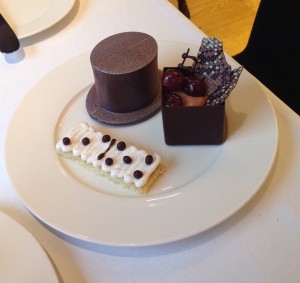 Deciding who should have which cake was almost as competitive as playing the game and in the end we cut most of them in half – so we both won!
Deciding who should have which cake was almost as competitive as playing the game and in the end we cut most of them in half – so we both won!
The evening found me delivering a lecture to the Friends of the Museum of London on Lord Mayors and Livery Companies, using objects in the Museum’s collection to illustrate the talk. From the first mayor of London, Henry Fitzailwyn, in 1189 to the current Lord Mayor, Lord Mountevans, via the Worshipful Companies of Mercers, Brewers, and Tax Advisors, among others. It’s lovely to be able to talk about museum objects and entice the Friends to revisit and look at the collection in a new light.
After all, who would look at the portrait of Lord Mayor William Hewett (check it out in the Medieval Gallery at the Museum of London) and think that this rather austere looking citizen promised his daughter’s hand in marriage to his apprentice?
As a child, Anne Hewett fell from a window in their house on London Bridge into the teeming waters below and Edward Osbourne jumped in to save her. When years later rich and noble gentlemen came a calling, Lord Mayor Hewett reportedly said: “Osbourne saved her, so Osbourne can have her!”
Tuesday
I’d promised to spend the day with Laura, a trainee Blue Badge guide who is about to take her final exams and who, like all of us after 2 years hard slog, was starting to feel like she couldn’t do this. I remember the feeling well – you’ve studied hard, learnt more than you thought possible about a huge number of topics (royalty, art, history, agriculture, architecture, cathedrals – the list is endless), honed your skills, walked London’s streets, and now you have to sit a written paper, pass a coach panoramic exam, and qualify to guide in Westminster Abbey, the British Museum, the Tower of London and St Paul’s Cathedral. Six exams in two weeks – it’s tough.
When I was training as a guide others freely gave me their time and knowledge and I feel it’s only right to pass it on – but did it have to be at the Tower? In February? On what felt like the coldest day of the year??
I froze (even with my thermals on) while Laura delivered her commentaries on the Bloody Tower, Traitors Gate, Execution Site and Jewel House, and was then very relieved when she admitted that she needed help with the armour in the White Tower. Hurrah – indoors, in the warm!
Henry VIII’s horse armour reminds you that he was an athletic hunk in his youth, and in love with Katherine of Aragon. He really was a knight in shining armour on a white charger!
The garniture (a mix and match set of armour for use in different tournament events; joust and foot combat) on the other hand is Henry older and fatter. But it’s tricky to guide as, not only do you have to talk about Henry VIII (that’s the easy part), you also have to explain how the armour was made, including the difference between engraving and etching in the decoration. And you have to mention the codpiece! Without giggling!
Friday
Well, if I thought the Tower of London was cold, Stonehenge is even colder on a miserable February day.
Although I am qualified to guide at Stonehenge, I have never been back since I completed the Blue Badge course. Not for any other reason than I’ve never been offered a job there. So a fellow Blue Badge who guides there a lot (she’d been there twice this week already) took me down to give me a refresher ready for the start of the main season.
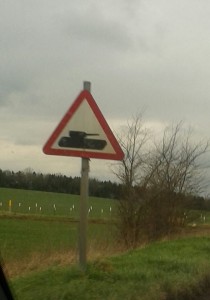 Located on Salisbury Plain, Stonehenge is right next to a large military base and the sound of gunshot often disconcerts visitors – they tend to get even more worried when they see the ‘Tanks Crossing’ signs!
Located on Salisbury Plain, Stonehenge is right next to a large military base and the sound of gunshot often disconcerts visitors – they tend to get even more worried when they see the ‘Tanks Crossing’ signs!
Now like many people, I’ve always just considered Stonehenge to be a bunch of really big old stones in a field. Sacrilege I know, and yes I know it’s 4,500 years old, an amazing feat of prehistoric engineering and a World Heritage Site. But they’re stones – big ones – in a field – and it was very, very cold!
However, after a visit with Lucy, I finally got it, and it is truly amazing. The thought of prehistoric man transporting the Sarsen stones each weighing up to 30 tons across the landscape from Marlborough and, in the case of the Bluestones (3-7 tons each) across mountains, valleys and rivers from Wales, and then levering them into upright positions with lintels on top creating a perfectly horizontal stone circle suspended 6m in the air is just unbelievable.
Archaeological evidence means we know when Stonehenge was built and how it was built, but not why it was built. Theories abound; it’s a place of ancient worship, a centre of healing, an astronomical computer, a ceremonial site, a druid temple (the druids came along much later by the way), and even an alien site – very Stargate SG1!
And if you’ve never been, then you should go – but did I mention it’s cold?
Diary of a Guide…Dazzling Tattoos
Work-wise, it’s been a bit of a quiet week. January and February tend to be the quietest months for tour guides, with ‘the season’ picking up around Easter. However, what the quiet period does do is give you time to catch up on exhibitions, update your knowledge and seek new business. So this week was all about meetings and ink!
Tuesday
 Tuesday saw me back at The View From The Shard, and sometimes I really do feel like I live there. Not that I’m complaining, as the view from the top is different every time I see it. No the landmarks don’t change, but the weather does and that changes the view. These days I am there so often that they’ve now given me my own name badge and pass to get in!
Tuesday saw me back at The View From The Shard, and sometimes I really do feel like I live there. Not that I’m complaining, as the view from the top is different every time I see it. No the landmarks don’t change, but the weather does and that changes the view. These days I am there so often that they’ve now given me my own name badge and pass to get in!
Today I was accompanying a small group of Blue Badge guiding colleagues on a familiarisation visit, so that they could meet the Travel Trade Team and become familiar with the logistics of guiding inside Western Europe’s tallest building. It was a beautifully sunny day, the view was wonderfully clear and we had a lot of fun ‘landmark spotting’ from the observation floor on Level 72. And trying to outdo each other with stories and facts about each one!
Thursday
Following a meeting on Bankside (fingers crossed for more about that in a few weeks if an exciting initiative comes off), I strolled along the South Bank to Westminster on my way to another meeting and happened upon what was HMS President’s last day moored on the Thames.
Built in 1918 as the Flower-Class sloop HMS Saxifrage (saxifrage is also known as the flower London Pride), she was an anti-submarine ship and spent the last days of World War I hunting U-boats. Her name was changed to President when she took up a permanent mooring on the Embankment in 1922 as a reserve ship. Now in private hands, and used as an event venue since 1982, HMS President was repainted in 2014 by Tobias Rehberger to commemorate her World War I service.
On Friday morning she was due to sail down the Thames and then the River Medway to Chatham, in order to clear the way for works on the new Thames Tideway Tunnel (or Super Sewer). During her time away, HMS President will undergo a refurbishment, and it is hoped that she will return to a new mooring on the Thames.
I was lucky to catch the old girl on her last day, although she did look slightly odd with her wheelhouse and funnel removed so she could fit under the bridges on her journey downstream.
HMS President’s dazzle camouflage was used to confuse enemy ships in the First World War, and her current ‘inking’ is similar to a full skin tattoo, which is what I encountered on Friday.
Friday
 A trip to the Museum of London for another meeting gave me time to take a look at their new free exhibition: Tattoo London (on until 8th May – www.museumoflondon.org.uk)
A trip to the Museum of London for another meeting gave me time to take a look at their new free exhibition: Tattoo London (on until 8th May – www.museumoflondon.org.uk)
Now whether you like tattoos, hate tattoos or are thinking of getting a tattoo, this is worth seeing. The exhibition covers the history of tattooing in London and also features contemporary London tattooists and life in tattoo parlours today.
As the proud owner of ink (got a tattoo for my 30th birthday), I had never really thought of tattoos as art nor tattooists as artists or craftsmen. But the exhibition showcases the skill and workmanship that goes into each design, and the Museum has commissioned some fabulous new designs by the tattooists featured in the exhibition.
As a City of London Guide, I particularly like Mo Coppoletta’s reworking of the City of London coat of arms
And, as a Londoner, I enjoyed deciphering the Cockney Rhyming Slang design by Lal Hardy.
It certainly beats my doodling when I’m in all those meetings!
Diary of a Guide…Prostitutes and Pleasure Gardens
Prostitutes and Pleasure Gardens seem to go hand in hand – as Joseph Addison said in the 18th century to the ‘mistress of the house’ when visiting New Spring Gardens (the forerunner to the famous Vauxhall Pleasure Gardens): “he should be a better Customer to her Garden, if there were more Nightingales, and fewer Strumpets”. And that’s kind of how my week went – strumpets everywhere.
Monday
First up were the prostitutes in the Cross Bones Graveyard in Borough. Scouting a route for a walk I’m leading in February, I wandered down Redcross Way to take a look at the ribbons and memorials on the old iron gate of the graveyard, and was delighted to find that the rather bleak and bare plot of land has been turned into a garden – the Goose Garden, or Cross Bones Garden of Remembrance.
Open to the public and free to visit, it was looking lovely, even in the cold January wind. I had a great chat with the gardener / volunteer who told me that all the work is being done by volunteers and supporters, and they rely heavily on donations to create this haven of peace and remembrance.
Cross Bones has always been a part of London’s history, and a visitor attraction in its own right as the burial place of approximately 15,000 people (estimated by Museum of London Archaeology); paupers and prostitutes who were not allowed to be buried in consecrated ground in the medieval era. Many of those burials were the Winchester Geese, prostitutes licensed to ply their trade in the stews of Bankside by the Bishop of Winchester, but known as the outcast dead as he would not allow them a decent Christian burial.
The vision for Cross Bones is for it to become a place for remembrance, meditation and performances, and it exudes a peaceful calm as you wander round the pond, memorials and wild flowers, and contemplate the prostitutes buried there hundreds of years ago.
Cross Bones graveyard and garden is well worth a visit if you’re in the area, or maybe go along to one of the Vigils for the Outcast Dead that take place on the 23rd of every month at 7.00pm. Take a look at their website for more information or to donate / help out – www.crossbones.org.uk
Wednesday
Wednesday evening saw me make my way to Westminster Archive Centre to give a talk at the City of Westminster Guides’ monthly meeting, as the planned speaker had to postpone due to a family bereavement. I’d agreed to step in while at the Westminster Guides new year bash the previous Saturday evening – note to self: never agree to give a talk while having a drink in a pub (or at least look at your diary first!).
It wasn’t a major problem but, after spending the entire day on my feet delivering training in The View From The Shard, slumping on the sofa was an attractive option. Instead, there I was in front of a room full of experienced and knowledgeable Westminster Guides (tough audience) giving a talk on Marylebone Pleasure Gardens: A Place To See and Be Seen.
Hence, my second encounter this week with prostitutes (or strumpets)!
Now I love talking about pleasure gardens. They are full of interesting characters, and really capture a varied slice of London life in the 18th and early 19th centuries – the aristocracy and celebrities rubbing shoulders with servants, the working classes and, in some cases, the criminal classes. The dark corners of pleasure gardens were rich pickings for pickpockets, and prostitutes only had to pick up one wealthy customer and they probably didn’t have to work for the rest of the week!
They really were the Hello or Okay magazine of their day, where you could eavesdrop on conversations, gawp at who was wearing what, and gossip over who was having a liaison with who!
Marylebone Pleasure Gardens, unlike the more famous Vauxhall, Ranelagh and Cremorne, was quite short-lived as it opened in 1738 and closed in 1776. However, it was a popular haunt of the rich and famous; Handel composed popular songs for the gardens, Dick Turpin is rumoured to have stolen a kiss from the schoolmaster’s wife there, and the entertainments included firework displays and bare-knuckle boxing (and that was just the ladies – I’m not joking!).
Located in the grounds of, what was then, the Rose of Normandy Tavern and the old manor house, the entrance would have been towards the top end of Marylebone High Street today (almost opposite the old parish churchyard), and the original entrance fee of 6d was priced to keep the riff-raff out. Clearly that didn’t work!
Sadly nothing remains of the gardens, but you can get a good idea of what they would have been like if you visit the Museum of London’s recreation of Vauxhall Pleasure Gardens (www.museumoflondon.org.uk).
The talk went well, I managed to answer most of the questions (did I mention guides are a tough audience?) and then repaired to the pub for a drink – guides are a sociable bunch, and it is customary to partake of a glass or two after any event.
Friday
I finished my week back at The View From The Shard (www.theviewfromtheshard.com), delivering more training to turn some of their Guest Ambassadors into tour guides. The view of London from the top of The Shard really speaks for itself, but sometimes visitors want a guided tour with someone who can point out landmarks, tell them about London’s history, share stories about what they can see, and talk about the building itself. It’s what a guide does – brings it alive, and helps people to see what they are looking at!
It’s always great fun working with the team there, and today was no exception as the group was enthusiastic and passionate about the training. Oh, but it was windy up on Level 72, and chilly, but delivering a demonstration tour at 800 feet up in the sky is a good way to show the trainees some of the challenges they will face.
Now I always like to start tour training sessions discussing fears and what is the worst thing that could happen to you on a tour, and this time we really did go from the sublime to the ridiculous. In among the usual fears of going blank, not being able to answer a question and keeping the group interested, we also had someone throwing up, zero visibility and…a seagull hitting the window?? I am not aware that any seagulls have actually hit The Shard, but it could be a real problem, so an entertaining discussion ensued on what you should do if one ever did.
Personally, I’d get their window cleaners up there quick!
While there, I got a sneak preview at their Valentine’s Day plans. The View’s ‘Height of Winter’ experience was due to finish at the end of January, and the festive decorations in the Level 1 ticket hall and shop were in the process of being replaced for Valentine’s Day by giant Love Hearts dangling from the ceiling.
The View From The Shard can be a very romantic place, especially if you visit at sunset, and Valentine’s can also be very popular for marriage proposals. So I can’t imagine you’ll find any strumpets in The View From The Shard, but come February 14th, you may find love?!
Diary of a Guide…Fanning Pepys
Last week saw a welcome return, twice, to very familiar territory – the Museum of London where I used to work.
My first visit was with a group of volunteer tour guides from Alexandra Palace. I delivered some tour training for them last year and, as part of that, had promised to take them on a tour of the museum – all 2,000 years of London’s history in about an hour! I call it ‘High Speed History’ and led a whistle-stop tour from the founding of Roman Londinium in AD47 through to the 2012 Olympic Games.
Being a largish group, I stuck to what I call the big ticket items; the Roman Wall, Medieval St Paul’s Cathedral, Wellclose Prison Cell, Unic Taxi, Selfridges Lift and, of course, the Lord Mayor’s State Coach.
The coach, built in 1757 and used every year in the Lord Mayor’s Show come rain or shine (and it usually rains), is my favourite object and I get very geeky about it. It cost £860 when it was built by the coachmaker, Joseph Berry, and looks wonderfully glamorous. Although I am reliably informed (never having ridden in it myself) that the coach is not as comfortable as it looks. Firstly, under all that gold leaf, it is made of wood and is not waterproof. It also has no heating (and the Show is held in November), plus no suspension so it rocks from side to side when moving – Lord Mayors occasionally feel seasick. And, just when you think it can’t get any worse, they didn’t have rubber in the 18th century, so those tyres are made of metal. Terribly uncomfortable on the bottom!
Oh, and those horses by the way, they’re fibreglass (the Museum doesn’t do taxidermy) and were made by British artist, David Hayes. Wonderfully lifelike, they are all male and are anatomically correct – feel free to look next time you’re there, just don’t be surprised if the staff give you funny looks!
On my second visit, I had more time to spend, as the group was much smaller and was one that I often take on tours (my ‘Bromley’ Ladies). The joy of a different size and type of group is that, although you are effectively doing the same tour, you can vary the objects. It can be more intimate and it becomes a completely different tour. So I could focus on smaller objects that people often overlook; silver coins from the reign of Alfred the Great, pilgrim badges commemorating Thomas a Becket, a print of Charles I’s execution.
Another object I included on the tour was a small case of fans, and I was fortunate recently to be invited to the opening of ‘Treasures of The Fan Museum’ to celebrate The Fan Museum’s 25th anniversary.
Situated in two early 18th century townhouses in Greenwich, The Fan Museum is the creation of Helene Alexander, founded in 1991 with her personal collection amassed over 30 years. Since then, the collection has grown and includes some beautiful pieces; delicate lace fans, ivory fans and art deco fans. In all they have a collection of over 5,000 fans and, in pride of place at the exhibition, is the fan held by Elizabeth I in the Ditchley Portrait (that’s in the National Portrait Gallery). Photography is not allowed at the Fan Museum so do take a look at their website (www.thefanmuseum.org.uk) and visit one day as it is absolutely charming.
While over at Greenwich, I also took the opportunity to visit the Samuel Pepys: Plague, Fire, Revolution exhibition at the National Maritime Museum. Wonderful stuff with a fabulous overview of his life as diarist, navy clerk, husband and overall ‘man about town’. It’s on until 28th March and worth seeing.
Coincidentally, a couple of days later I strolled down Stew Lane (just love those City street names) to The Pepys Riverside Bar and Dining Room for the annual City of London Guides Class of 2009 get-together. One of the great things about being a guide is that during your training you make good friends with people from all walks of life who keep in touch and offer support, knowledge and laughter. Such was the evening at The Pepys – the wine flowed, the food was plentiful and the company convivial.
However, I am ashamed to say that, when it came to the picture quiz (compiled by one of our colleagues), deep failure ensued as my team came last! Prizes, bought specially to commemorate the 400th anniversary of Shakespeare’s death this year, and in honour of the view of The Globe Theatre across the water, were Shakespeare rubber ducks for the winners, and for us losers….Macbeth badges.
Perhaps I should take a leaf out of Pepys’s book (or should that be diary): “Since my leaving the drinking of wine, I do find myself much better, and do mind my business better, and do spend less money, and less time lost in idle company”.
Diary of a Guide…Thermals, Lights and Looking for Harry!
As the temperature plummeted this week, it was finally time to dig out the tour guide’s winter warmer – the thermals! Yep, once winter hits thermal underwear is a lifesaver, and I’m not just talking thick socks. Oh no, I go the whole hog; long-sleeved thermal vest, thermal hiking socks and, the most glamorous part of all, thermal long johns. Now you may mock, but if you’ve ever guided a group round Millwall Dock in the snow (as I did a couple of years back) then thermals are essential!
I topped the thermals with trousers, a thick jumper, padded coat (think duvet diva), scarf, hat and woolly gloves to take a group to the Tower of London – one of the coldest places as the wind whips off the river Thames.
A couple of days later, and still wrapped up warm, I thought I’d make the most of a quieter time of year to brush up on one of my bete-noirs – Oxford! Now Oxford is a great place and my visitors love it when I take them there, especially those from overseas, because it’s old, picturesque, has loads of literary connections and is full of history. But all those colleges (there are 38 of them) look the same and it can be very confusing.
So time to sort out All Souls from Worcester, Harry Potter from Alice in Wonderland, and the Sheldonian Theatre from the Radcliffe Camera (which is not actually a camera by the way, it’s a library).
First up was Christ Church, founded in 1525 by Cardinal Wolsey as Cardinal college and re-founded complete with a name change following Wolsey’s fall from grace. Probably the best known of all the colleges, Christ Church is heaving during the summer months as hordes of overseas youngsters troop through the Great Hall just to take a photo of ‘Hogwarts’ (it was used in the films as the dining hall).
The day I visited, it was virtually deserted and I could take my time admiring the medieval hammer beam ceiling and looking at the portraits that line the walls. You’ll find Charles Dodgson (aka Lewis Carroll), who spent most of his life at Christ Church as an undergraduate and then mathematics lecturer, just inside the entrance door. You won’t find Harry Potter anywhere (loads of muggles but no wizards), but if you look carefully you will find the Cheshire Cat and the Dodo from Alice in Wonderland carved into two of the dining chairs.
Despite all the tourists, three meals a day are served here and the undergraduates eat well, and for a very reasonable cost – the lunch menu the day I visited had sweet and sour pork for £1.75 and salmon in a pinenut crust for £2.50.
The Cathedral, which many tourists bypass, is also well worth a visit with its shrine to St Frideswide, patron saint of Oxford and who’s priory was originally on this site, complete with Watching Loft to ensure pilgrims respected the Shrine.
Colleges then came thick and fast as I made my way through as many as I could (not all are open to the public – this is a working university after all). Magdalen (pronounced ‘mawdlin’) with its New Building (well, it only dates from the 1700s), unusual stained glass window in the chapel, outdoor pulpit and herd of fallow deer is worth the walk to the end of the High Street.
And at All Souls, founded to remember the fallen in the Hundred Years War with France, the porter was incredibly welcoming. We empathised with each other over the summer hordes, before he informed me that the wonderful sundial in North Quad was in fact upside down! According to the porter it was moved by architect Nicholas Hawksmoor in the 18th century, but the website states it was moved in the Victorian era – these things, as my old architecture lecturer used to say, are “lost in the mists of time”!
Having trooped through the colleges, there are many ways to tell them apart and each one has its own quirk; Brasenose has noses (large, bulbous noses on tiny heads – lots of them), New College isn’t new at all (it’s one of the oldest founded in 1379), Merton has a Quad called Mob (no one really knows why – it may have referred to the undergraduates who lived there) and Hertford’s buildings are connected by the Bridge of Sighs.
‘Colleged’ out, I explored the Covered Market with its fresh fish stall, butcher’s, pie shop and greengrocer’s. Shops as they used to be when I was a kid, plus the most wonderful cake shop where you can watch through the windows as they make and ice amazing cakes.
My visit finished with a trip to Oxford Castle Unlocked – the remains of a Norman castle, built by Robert d’Oilly in 1071. The castle can only be visited on an official tour, so along I went on a guided tour with convicted felon ‘George Strap’. As a guide, it’s always interesting to see others in action and 18th century George delivered an informative and entertaining tour. In full costume too – you don’t get that on my tours!
The history of the castle was brought to life as we climbed to the top of St George’s Tower and down to the crypt; the siege conducted by Stephen and the escape of Matilda during the 12th century civil war, and its use as the royal court and home to King Charles I during the English civil war in the 1600s.
Tales of prisoners, their crimes, punishment and execution followed, from the early days as a castle prison, then a House of Correction and finally as HMP Oxford, with the last hanging in 1952 and the prisoners still occupying the Victorian cells until it finally closed in 1996.
Back in London, I joined the thousands who turned out in the bitter cold to marvel at Lumiere London and what a show it was! From the Circus of Light in King’s Cross, to the Garden of Light in Leicester Square, like everyone else I was entranced. Got to confess, I was a bit disappointed with Plastic Islands in the fountains at Trafalgar Square – I know it was symbolic of the marine litter in the Pacific Ocean but, philistine that I am, to me it just looked like a load of plastic bottles chucked in the fountain.
But my absolute favourite was the Spirit of Light by Patrice Warrener on Westminster Abbey. As someone who regularly guides there, I loved the colours that illuminated the West Front and the statues of the 20th Century Martyrs. Reminiscent of the medieval era when bright colours would often have adorned the sculpture and walls of palaces – it was truly awe-inspiring.
However, the cold weather looks set to continue, so if you see a tour guide waddling round London looking like a Tellytubby, I didn’t put on weight over Christmas – it’s all those thermals I’m wearing.
Diary of a Guide…1Resolution and 30 Magical Years!
New Year, New Start and absolutely no point in making all those resolutions that I won’t stick to about drinking less, eating less, getting fit. So instead, one that I will keep – to write a blog. I’ve been a tour guide for 8 years, and recently got onto social media, so the next logical step seems to be this blog. So welcome to Diary of a Guide – and the start of 2016.
I’m fortunate to spend a lot of time at The View from The Shard, as I work with the wonderful team there as both a trainer (well someone has to teach their Guest Ambassadors which landmark is which – not easy at 800 feet) and occasional tour guide for private events. So New Year’s Eve was spent at London’s highest party in The View from The Shard, with the fabulous acoustic band The Diamond Boys (www.thediamondboys.co.uk) and a bird’s eye view of the fireworks.
Managed to catch a few hours sleep, having had a free ride home on the Underground (thanks TfL for a safe and speedy journey), before heading off to the London New Year’s Day Parade as a guest of Westminster City Council. Confession time (and no, this is not that kind of diary) – I have never been to the New Year’s Day Parade before! In my defence, I’ve often been working, but can you believe it’s been going for 30 years?!
#30 Magical Years was the most wonderful parade, and the British, well we do pomp, ceremony and tradition really well. But, for sheer spectacle and razzamatazz, you can’t beat the Americans!
The parade was kicked off by the Olivet Nazarene University Tiger Marching Band from Illinois, USA, closely followed by the arrival of Lady Flight, Lord Mayor of City of Westminster in a horse-drawn landau and the borough mayors in an old Routemaster. Then followed over 8,000 performers.
Floats from 17 London Boroughs were raising money for charity. Hillingdon won the borough competition with their ‘Dreams Come True’ float and performers, winning £10,000 for the Mayor’s charity appeal. My own borough, Merton, got 5th place and £4,000 with ‘Merton’s Magic Carpet Ride’.
Cheerleaders abounded; over 200 of them in one group – all smiling and dancing despite the bitter cold.
Plus the best of British quirkiness with the Donkey Breed Society, miniature steam vehicles, vintage cars, and for the grand finale illusionist Darcy Oake performing a death defying escape from a locked box filled with water. He sure can hold his breath for a long time!
Winter is off-peak season for tour guides, so a time to rest, refresh your tours and do research, but I had my first job of 2016 on Monday 4th January with the delivery of a lecture on ‘Advertising Art’ to a group in Richmond. Researching it had been fun as I dived into the world of vintage posters for Pear’s Soap, Camel cigarettes, Bisto, Oxo and, my personal favourite, Cocaine Toothache Drops.
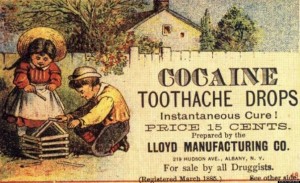
The group loved the nostalgia – most being of an age where they could remember ad campaigns of the 1950s, ‘60s and ‘70s (though not the toothache drops of 1885), and we had fun seeing who could remember which slogans (Beanz Meanz Heinz anyone?).
However, the interesting point being that if you take away the product name and put the original artwork in a nice frame and stick it in an art gallery, most people would view it very differently. So the next time an advertising poster catches your eye on a hoarding or on the Underground, try it.
My week finished as it ended, back at the top of The Shard. This time for a bird’s eye view of the Blessing of the Thames.
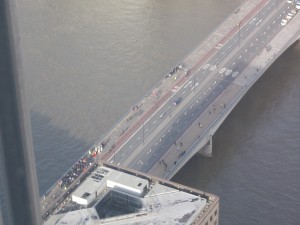
The Right Reverend and Right Honourable Dr Richard Chartres leading the congregation onto London Bridge
Wonderful to see the Bishop of London processing from Southwark Cathedral to the middle of Lond0n Bridge to join with the congregation of St Magnus the Martyr to bless the river and all who use her. I particularly loved it when the bishop just stepped straight onto the road to lead his flock across to the other side and all the traffic just stopped – oh, to have the power of a crosier as I lead my groups across London’s roads!

